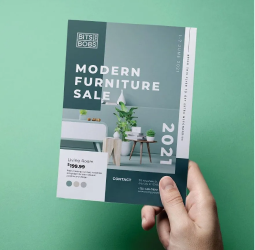Discover the most popular flyer dimensions & how they are used.

Discover the most popular flyer dimensions & how they are used.
Printing flyers is an excellent, cost-effective piece of marketing collateral for promoting events, new products and special offers.

Size: 99 x 210mm
As one of the most popular options, the size of DL flyers allows for maximum portability while still maintaining a sophisticated look. Popular as inserts for mail campaigns and letterbox drops.

Size: 105 x 148mm
The same size as a postcard but lightweight, A6 flyers are a smaller but handy option for inserts and handouts.

Size: 148 x 210mm
Offering more space for copy and images, A5 flyers are a popular choice for leaflet drops and event handouts that need to contain more information.

Size: 210 x 297mm
With ample space to get creative and explain your offer or event in detail, A4 sized flyers are the ideal solution for those wanting to include more images and information in their flyer.

Size: 297 x 420mm
The largest of the group, the bold A3 flyer is commonly used for menus and promoting community events.
Unsure which flyer size is suitable for your project? Use our handy flyer chart to compare your options and get started on designing an impressive flyer.

The available space of your flyer will depend on its size. Luckily, the double sided format of flyers means there is more space to get creative with design when compared to other promotional materials.
Make the most out of your flyer size by incorporating different sized texts, high definition images and eye-catching layout choices. And if you find yourself struggling to keep your design within the flyer’s dimensions, then you may want to consider upgrading to a larger design. To contextualise the various flyer sizes, look no further than our guide for paper sizes from A0 to A6.
Are you going to be hand delivering it by mail? Will you be handing the flyers out at an event or presenting them on a wall or bulletin board amidst other flyers?
Different flyer designs suit various distribution methods. Flyers that will be delivered by mail will have to be small enough to fit through the slot of a mailbox, which is why the DL size is popular for mail distribution. Similarly, flyers handed out at events should not be so large that they become a nuisance to the people receiving them.
Flyers allow for greater creativity in comparison to other promotional materials. However, it’s important to prioritise readability in your design to ensure that you don’t overwhelm the reader with clashing colours or too-small font.
Your distribution plans will also influence your flyer’s design. If your flyer needs to stand out amongst a crowd of your competitors’ flyers, then you’ll benefit from a brighter design with more urgent text that is large enough to attract the eyes of those passing by. However, if you are planning on handing out flyers to potential customers at conferences, elements like larger text and vibrant colours may not be as crucial to its design.
Often considered the ‘standard’ flyer size, the DL flyer size measures at 99mm by 210mm, which is the same size as one-third of an A4 piece of paper. Their tall and slim design makes them a popular choice for price lists, letterbox drops, inserts for direct mail campaigns, menus and other types of promotions.
DL flyers can come in double-sided and folding formats, both offering plenty of space to get creative with your design without compromising on the amount of information you include.


Earn 1 Qantas Point for every $1 spend at your local Snap Centre. Find out more